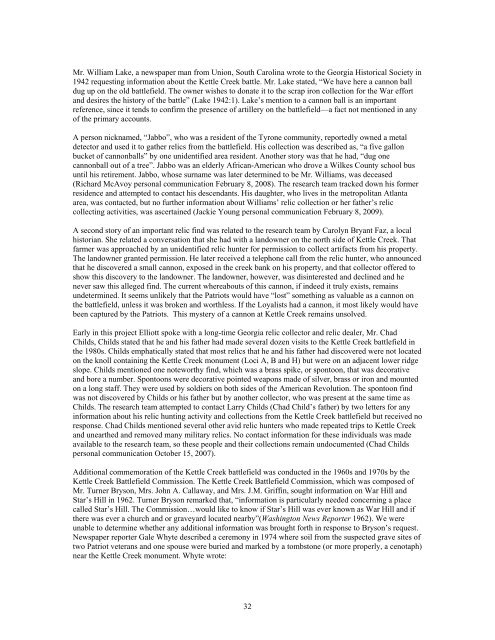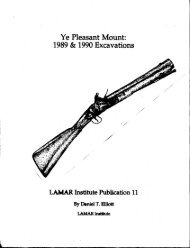Stirring Up a Hornet's Nest: - UGA Laboratory of Archaeology ...
Stirring Up a Hornet's Nest: - UGA Laboratory of Archaeology ...
Stirring Up a Hornet's Nest: - UGA Laboratory of Archaeology ...
Create successful ePaper yourself
Turn your PDF publications into a flip-book with our unique Google optimized e-Paper software.
Mr. William Lake, a newspaper man from Union, South Carolina wrote to the Georgia Historical Society in<br />
1942 requesting information about the Kettle Creek battle. Mr. Lake stated, “We have here a cannon ball<br />
dug up on the old battlefield. The owner wishes to donate it to the scrap iron collection for the War effort<br />
and desires the history <strong>of</strong> the battle” (Lake 1942:1). Lake’s mention to a cannon ball is an important<br />
reference, since it tends to confirm the presence <strong>of</strong> artillery on the battlefield—a fact not mentioned in any<br />
<strong>of</strong> the primary accounts.<br />
A person nicknamed, “Jabbo”, who was a resident <strong>of</strong> the Tyrone community, reportedly owned a metal<br />
detector and used it to gather relics from the battlefield. His collection was described as, “a five gallon<br />
bucket <strong>of</strong> cannonballs” by one unidentified area resident. Another story was that he had, “dug one<br />
cannonball out <strong>of</strong> a tree”. Jabbo was an elderly African-American who drove a Wilkes County school bus<br />
until his retirement. Jabbo, whose surname was later determined to be Mr. Williams, was deceased<br />
(Richard McAvoy personal communication February 8, 2008). The research team tracked down his former<br />
residence and attempted to contact his descendants. His daughter, who lives in the metropolitan Atlanta<br />
area, was contacted, but no further information about Williams’ relic collection or her father’s relic<br />
collecting activities, was ascertained (Jackie Young personal communication February 8, 2009).<br />
A second story <strong>of</strong> an important relic find was related to the research team by Carolyn Bryant Faz, a local<br />
historian. She related a conversation that she had with a landowner on the north side <strong>of</strong> Kettle Creek. That<br />
farmer was approached by an unidentified relic hunter for permission to collect artifacts from his property.<br />
The landowner granted permission. He later received a telephone call from the relic hunter, who announced<br />
that he discovered a small cannon, exposed in the creek bank on his property, and that collector <strong>of</strong>fered to<br />
show this discovery to the landowner. The landowner, however, was disinterested and declined and he<br />
never saw this alleged find. The current whereabouts <strong>of</strong> this cannon, if indeed it truly exists, remains<br />
undetermined. It seems unlikely that the Patriots would have “lost” something as valuable as a cannon on<br />
the battlefield, unless it was broken and worthless. If the Loyalists had a cannon, it most likely would have<br />
been captured by the Patriots. This mystery <strong>of</strong> a cannon at Kettle Creek remains unsolved.<br />
Early in this project Elliott spoke with a long-time Georgia relic collector and relic dealer, Mr. Chad<br />
Childs, Childs stated that he and his father had made several dozen visits to the Kettle Creek battlefield in<br />
the 1980s. Childs emphatically stated that most relics that he and his father had discovered were not located<br />
on the knoll containing the Kettle Creek monument (Loci A, B and H) but were on an adjacent lower ridge<br />
slope. Childs mentioned one noteworthy find, which was a brass spike, or spontoon, that was decorative<br />
and bore a number. Spontoons were decorative pointed weapons made <strong>of</strong> silver, brass or iron and mounted<br />
on a long staff. They were used by soldiers on both sides <strong>of</strong> the American Revolution. The spontoon find<br />
was not discovered by Childs or his father but by another collector, who was present at the same time as<br />
Childs. The research team attempted to contact Larry Childs (Chad Child’s father) by two letters for any<br />
information about his relic hunting activity and collections from the Kettle Creek battlefield but received no<br />
response. Chad Childs mentioned several other avid relic hunters who made repeated trips to Kettle Creek<br />
and unearthed and removed many military relics. No contact information for these individuals was made<br />
available to the research team, so these people and their collections remain undocumented (Chad Childs<br />
personal communication October 15, 2007).<br />
Additional commemoration <strong>of</strong> the Kettle Creek battlefield was conducted in the 1960s and 1970s by the<br />
Kettle Creek Battlefield Commission. The Kettle Creek Battlefield Commission, which was composed <strong>of</strong><br />
Mr. Turner Bryson, Mrs. John A. Callaway, and Mrs. J.M. Griffin, sought information on War Hill and<br />
Star’s Hill in 1962. Turner Bryson remarked that, “information is particularly needed concerning a place<br />
called Star’s Hill. The Commission…would like to know if Star’s Hill was ever known as War Hill and if<br />
there was ever a church and or graveyard located nearby”(Washington News Reporter 1962). We were<br />
unable to determine whether any additional information was brought forth in response to Bryson’s request.<br />
Newspaper reporter Gale Whyte described a ceremony in 1974 where soil from the suspected grave sites <strong>of</strong><br />
two Patriot veterans and one spouse were buried and marked by a tombstone (or more properly, a cenotaph)<br />
near the Kettle Creek monument. Whyte wrote:<br />
32










